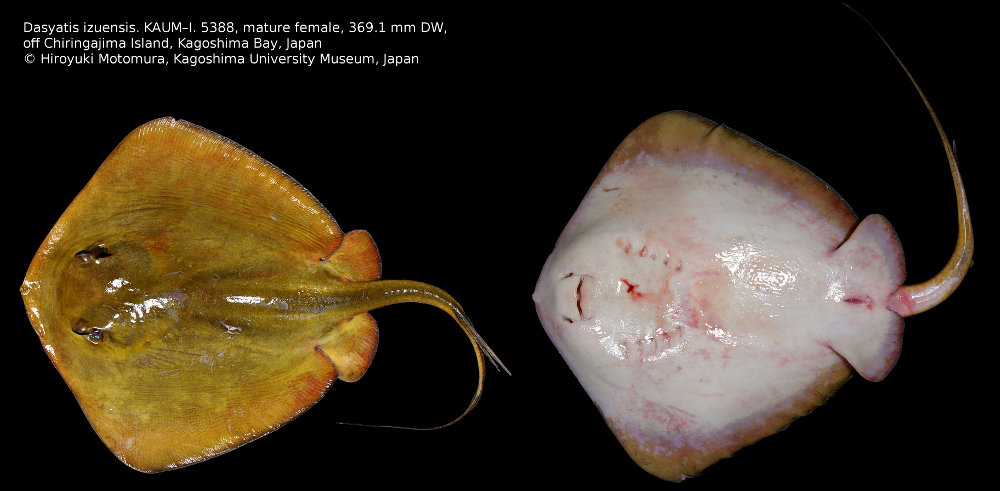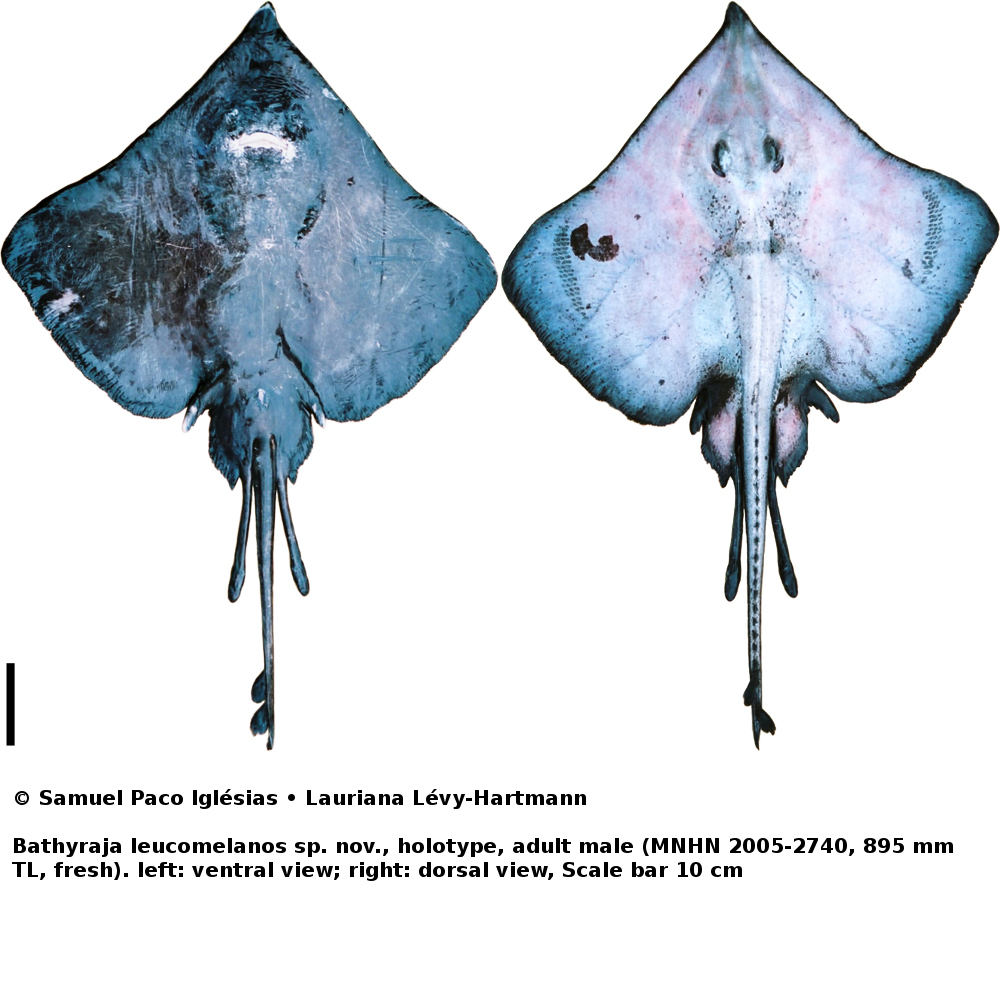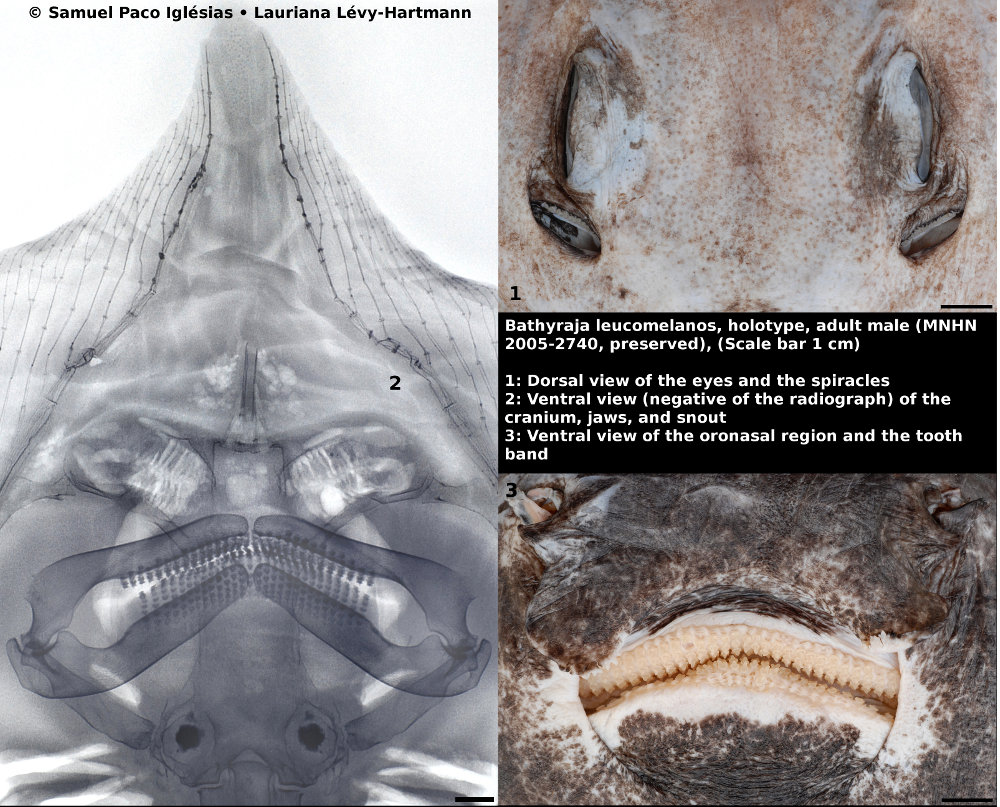NEWSLETTER 02/2012 18. February 2012
Daily News now on facebook ![]() ! Please use the "Like" button, and inform your friends!
! Please use the "Like" button, and inform your friends!
NEW PARTNERS:
- Clinton Duffy, New Zealand Department of Conservation, Research Associate Auckland War Memorial Museum, member IUCN Shark Specialist Group (Australia and Oceania)
- Dr. R. Dean Grubbs, Florida State University Coastal and Marine Laboratory, St. Teresa, Florida, USA (Homepage)
- Jeff M. Whitty, Team Sawfish, Centre for Fish and Fisheries Research, Murdoch University, Perth, Australia
- José-Carmelo Corral, Museo de Ciencias Naturales de Álava, Vitoria-Gasteiz, Spain
STATISTIC:
|
November |
December |
January |
February |
|
|
papers: |
13.774 |
13.930 |
14.191 |
14.522 |
|
recent: |
10.773 |
10.926 |
11.179 |
11.591 |
|
fossil: |
3.001 |
3.004 |
3.012 |
3.021 |
|
evaluated: |
8.576 |
8.654 |
8.821 |
9.003 |
|
free downloads: |
2.874 |
2.969 |
3.014 |
3.202 |
|
saved abstracts: |
4.943 |
5.255 |
5.397 |
5.612 |
|
saved DOI |
3.794 |
4.044 |
4.158 |
4.223 |
|
database entries "described species“ |
44.976 |
47.913 |
48.112 |
50.044 |
|
different species names |
11.288 |
11.624 |
11.702 |
11.740 |
|
valid recent species |
1.197 |
1.190 |
1.190 |
1.193 |
|
Database entries "types“ |
5.766 |
5.800 |
5.852 |
5.888 |
|
Detailed data for "types" |
3.608 |
3.665 |
3.915 |
3.970 |
|
Type mapping |
2.876 |
2.952 |
3.159 |
3.190 |
---------------------------------------------------------------------------------------------------------------------------------------------------------
Please send your news, press releases or notifications of events to me by e-mail !
Please inform me about missing papers by e-mail!
---------------------------------------------------------------------------------------------------------------------------------------------------------
NEW IMAGES AT SHARK-REFERENCES:
Thanks to Peter Last and Bernhard Séret for the images of the new skates Brochiraja heuresa LAST & SÉRET, 2012 and Brochiraja vittacauda LAST & SÉRET, 2012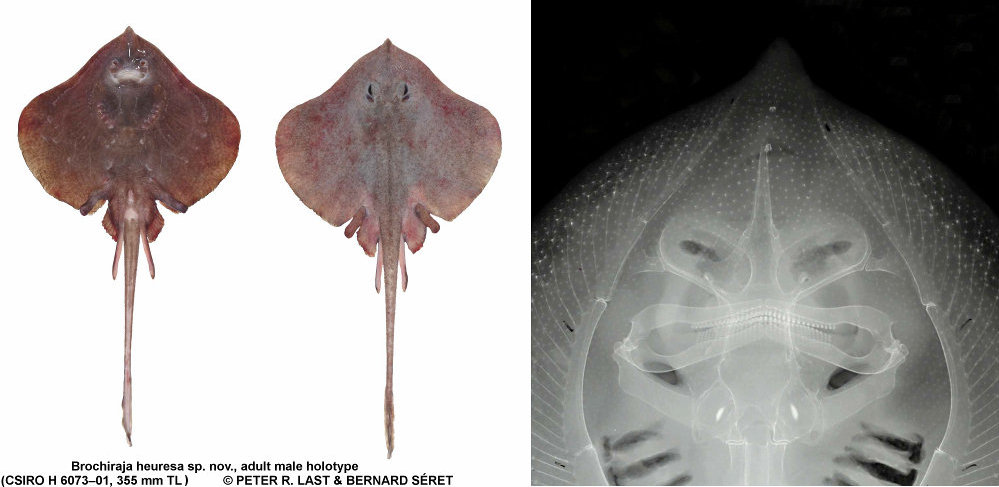
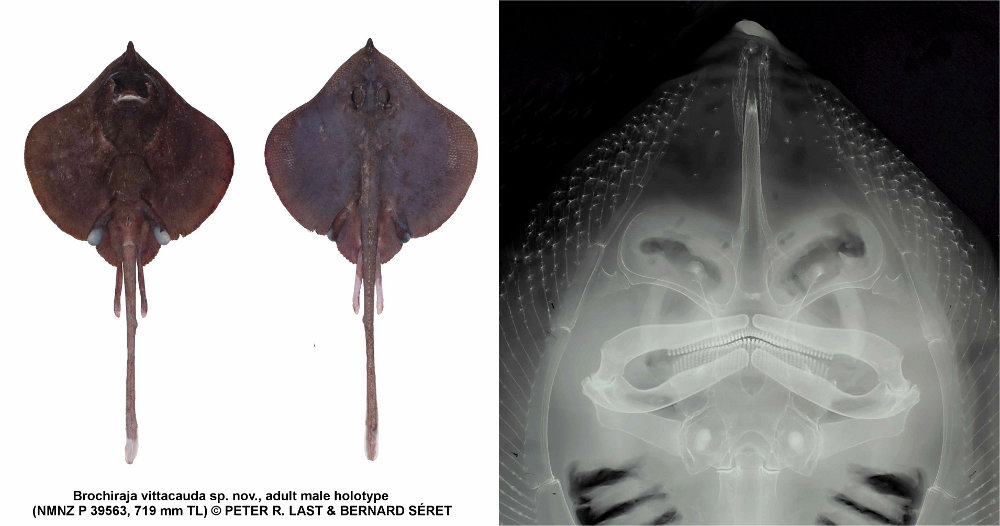
A new image of the rare Dasyatis izuensis Nishida and Nakaya, 1988 now at shark-references! Thank's to Hiroyuki Motomura, The Kagoshima University Museum, Korimoto, Japan
Many thanks to Samuel Paco Iglésias und Lauriana Lévy-Hartmann for the images of the new species Bathyraja leucomelanos IGLÉSIAS & LÉVY-HARTMANN, 2012
---------------------------------------------------------------------------------------------------------------------------------------------------------
Please send your images of elasmobranchs to me by e-mail!
---------------------------------------------------------------------------------------------------------------------------------------------------------
NEW PAPERS:
FOSSIL
FOSSIL -PAPERS:
CORRAL, J.C. & BARDET, N. & PEREDA-SUBERBIOLA, X. & CAPPETTA, H. 2012 First occurrence of the sawfish Onchosaurus from the Late Cretaceous of Spain. Journal of Vertebrate Paleontology, 32 (1): 212-218 http://dx.doi.org/10.1080/02724634.2012.620675
GARCÍA, E.X.M. & BALBINO, A. & ANTUNES, M. & RUIZ, F. & CIVIS, J. & ABAD, M. & TOSCANO-GRANDE, A. 2011 Los tiburones Carcharhiniformes (Chondrichthyes, Galeomorphii) del Plioceno inferior de la Formación Arenas de Huelva, suroeste de la cuenca del Guadalquivir, España. Revista Mexicana de Ciencias Geológicas, 28 (3): 474-492
LEPAGE, Y. & CUNY, G. & DESQUESNE, A. 2011 Première découverte d’Acrodus nobilis Agassiz, 1838, dans le Sinémurien du Cotentin (Normandie, France). Bulletin Sciences et Géologie Normandes, (3): 7-13
RECENT
RECENT-PAPERS:
CABALLERO-RIVERA, D. & CRUZ-NIEVES, O.A. & OYOLA-CINTRÓN, J. & TORRES-NÚÑEZ, D.A. & OTERO-CRUZ, J.D. & LASALDE-DOMINICCI, J.A. 2011 Fourier transform coupled tryptophan scanning mutagenesis identifies a bending point on the lipid-exposed deltaM3 transmembrane domain of the Torpedo californica nicotinic acetylcholine receptor. Channels, 5 (4): 345-356
CARLSON, J.K. & HALE, L.F. & MORGAN, A. & BURGESS, G. 2012 Relative abundance and size of coastal sharks derived from commercial shark longline catch and effort data. Journal of Fish Biology, in press http://dx.doi.org/10.1111/j.1095-8649.2011.03193.x
CURTIS, T.H. & MACESIC, L.J. 2011 Observations of breaching behavior in juvenile bull sharks, Carcharhinus leucas. Florida Scientist, 74 (4): 253-257
DALY-ENGEL, T.S. & SERAPHIN, K.D. & HOLLAND, K.N. & COFFEY, J.P. & NANCE, H.A. & TOONEN, R.J. & BOWEN, B.W. 2012 Global Phylogeography with Mixed-Marker Analysis Reveals Male-Mediated Dispersal in the Endangered Scalloped Hammerhead Shark (Sphyrna lewini). PLoS ONE, 7 (1): e29986 http://dx.doi.org/10.1371/journal.pone.0029986
DAS, T. & SUNDARAM, S. & KHANDAGALE, P. & MHATRE, V. 2011 Observations on the fecundity of Rhynchobatus djiddensis (Forskal, 1775). Fishing Chimes, 31 (8): 28-29
DELPIANI, G. & FIGUEROA, D.E. & MABRAGAÑA, E. 2012 Description of the clasper of the Southern Thorny Skate Amblyraja doellojuradoi (Pozzi, 1935) (Chondrichthyes: Rajidae). Zootaxa, 3182: 57-64
ESCOBAR-SÁNCHEZ, O. & GALVÁN-MAGAÑA, F. & ROSÍLES-MARTÍNEZ, R. 2011 Biomagnification of Mercury and Selenium in Blue Shark Prionace glauca from the Pacific Ocean off Mexico. Biological Trace Element Research, 144 (1-3): 550-559 http://dx.doi.org/10.1007/s12011-011-9040-y
FORD, R. & GELSLEICHTER, J. & FRAZIER, B. & BELCHER, C. & GRUBBS, R.D. & PIERCY, A. 2011 Preliminary Analysis of Reproductive Periodicity of the Blacknose Shark (Carcharhinus acronotus) within its Atlantic Range. Abstract. American Elasmobranch Society 27th Annual Meeting, 7-12 July 2011. Minneapolis, MN.
GALLAGHER, A.J. & JACKSON, T. & HAMMERSCHLAG, N. 2011 Occurrence of tiger shark (Galeocerdo cuvier) scavenging on avian prey and its possible connection to several large-scale bird die-offs in the Florida Keys. Florida Scientist, 74 (4): 264-269
GIRESI, M. & RENSHAW, M.A. & PORTNOY, D.S. & GOLD, J.R. 2011 Isolation and characterization of microsatellite markers for the dusky smoothhound shark, Mustelus canis. Conservation Genetics Resources, in press http://dx.doi.org/10.1007/s12686-011-9484-6
GRUBBS, R.D. & CARLSON, J.K. & ROMINE, J.G. & CURTIS, T. & MCELROY, D. 2011 Save the Bay, Eat a Ray: A Purported Trophic Cascade Mediated by Declines In Large Shark Populations and the Consequences of Applying Simplistic Models to Complex Ecosystems. Abstract. American Fisheries Society, 141st Meeting, 4-9 September 2011, Seattle, WA.
GRUBBS, R.D. & CARLSON, J.K. & ROMINE, J.G. & CURTIS, T. & MCELROY, D. & MCCANDLESS, C.T. & MUSICK, J.A. 2011 Save the Bay, Eat a Ray: A Purported Trophic Cascade Mediated by Declines In Large Shark Populations and the Consequences of Applying Simplistic Models to Complex Ecosystems. Abstract. The Florida State University and Mote Marine Laboratory 8th William R. & Lenore Mote Symposium; Species Interactions in Marine Communities: The Invisible Fabric of Nature. 8-10 November 2011, Sarasota, Florida.
GUTTRIDGE, T.L. & GRUBER, S.H. & FRANKS, B.R. & KESSEL, S.T. & GLEDHILL, K.S. & UPHILL, J. & KRAUSE, J. & SIMS, D.W. 2012 Deep danger: intra-specific predation risk influences habitat use and aggregation formation of juvenile lemon sharks Negaprion brevirostris. Marine Ecology Progress Series, 445: 279-291 http://dx.doi.org/10.3354/meps09423
HANNAN, K.M. & DRIGGERS, W.B. & HANISKO, D.S. & JONES, L.M. & CANNING, A.B. 2012 Distribution of the Nurse Shark, Ginglymostoma cirratum, in the Northern Gulf of Mexico. Bulletin of Marine Science, 88 (1): 73-80 http://dx.doi.org/10.5343/bms.2011.1033
HO, J.-S. & LIN, C.-L. 2011 Redescription of Dinemoura discrepans Cressey, 1967 (Copepoda: Pandaridae) parasitic on four species of sharks off southeast coast of Taiwan. Folia Parasitologica, 58 (4): 311-317
HO, J.-S. & LIN, C.-L. 2012 Pagina tunica Cressey, 1964 (Copepoda, Pandaridae) parasitic on sharks of Taiwan. Journal of The Fisheries Society of Taiwan, in press
HOLLENSEAD, L. & CARLSON, J. & BETHEA, D. & GRUBBS, R.D. 2011 Monitoring Movement Patterns of Juvenile Smalltooth Sawfish (Pristis pectinata) Using Acoustic Monitoring and Tracking in a Nursery Habitat in Southwest Florida. Abstract. American Elasmobranch Society 27th Annual Meeting, 7-12 July 2011. Minneapolis, MN.
HOYOS PADILLA, E.M. & CEBALLOS-VÁZQUEZ, B.P. & GALVÁN-MAGAÑA, F. 2012 Reproductive Biology of the Silky Shark Carcharhinus falciformis (Chondrichthyes: Carcharhinidae) off the west coast of Baja California Sur, Mexico. Aqua, International Journal of Ichyology, 18 (1): 15-24
IGLÉSIAS, S.P. & LÉVY-HARTMANN, L. 2012 Bathyraja leucomelanos, a new species of softnose skate (Chondrichthyes: Arhynchobatidae) from New Caledonia. Ichthyological Research, 59 (1): 38-48 http://dx.doi.org/10.1007/s10228-011-0254-y
JIRIK, K.E. & LOWE, C.G. 2012 An elasmobranch maternity ward: female round stingrays Urobatis halleri use warm, restored estuarine habitat during gestation. Journal of Fish Biology, in press http://dx.doi.org/10.1111/j.1095-8649.2011.03208.x
KARL, S.A. & CASTRO, A.L.F. & LOPEZ, J.A. & CHARVET, P. & BURGESS, G.H. 2011 Phylogeography and conservation of the bull shark (Carcharhinus leucas) inferred from mitochondrial and microsatellite DNA. Conservation Genetics, 12 (2): 371-382 http://dx.doi.org/10.1007/s10592-010-0145-1
KOLMANN, M.A. & HUBER, D.R. & DEAN, M. & GRUBBS, R.D. 2011 Scaling of bite force generation in the Cownose Ray, Rhinoptera bonasus. Abstract. American Fisheries Society, 141st Meeting, 4-9 September 2011, Seattle, WA.
KOLMANN, M.A. & HUBER, D.R. & DEAN, M. & GRUBBS, R.D. 2011 Scaling of bite force generation in the Cownose Ray, Rhinoptera bonasus, with comments regarding on-bottom aquaculature. Abstract. Southeastern Ecology and Evolution Conference. 25-27 March 2011. Auburn, AL.
LANE, D.P. & MADHUMALA, A. & LEE, A.P. & TAY, B-H. & VERMA, C. & BRENNER, S. & VENKATESH, B. 2011 Conservation of all three p53 family members and Mdm2 and Mdm4 in the cartilaginous fish. Cell Cycle, 10: 4272-4279 http://dx.doi.org/10.4161/cc.10.24.18567
LAST, P.R. & SÉRET, B. 2012 Two new softnose skates of the genus Brochiraja (Rajoidei: Arhynchobatidae) from the deepwater slopes and banks of the Norfolk Ridge (South-West Pacific). Zootaxa, 3155: 47-64
LONG, D.J. & MCCOSKER, J.E. & KLAPFER, A. & DROGIN, S. 2011 Distribution of the prickly shark Echinorhinus cookei (Squaliformes: Echinorhinidae) in the Eastern Pacific Ocean. Pacific Science, 65 (4): 433-440 http://dx.doi.org/10.2984/65.4.433
MATICH, P. & HEITHAUS, M.R. 2012 Effects of an extreme temperature event on the behavior and age structure of an estuarine top predator, Carcharhinus leucas. Marine Ecology Progress Series, 447: 165-178 http://dx.doi.org/10.3354/meps09497
MCCOSKER, J.E. & LONG, D.J. & BALDWIN, C.C 2012 Description of a New Species of Deepwater Catshark, Bythaelurus giddingsi sp. nov., from the Galápagos Islands (Chondrichthyes: Carcharhiniformes: Scyliorhinidae). Zootaxa, in press
MENDONCA, F.F. & OLIVEIRA, C. & BURGESS, G. & COELHO, R. & PIERCY, A. & GADIG, O.B.F. & FORESTI, F. 2011 Species delimitation in sharpnose sharks (genus Rhizoprionodon) in the western Atlantic Ocean using mitochondrial DNA. Conservation Genetics, 12 (1): 193-200 http://dx.doi.org/10.1007/s10592-010-0132-6
MOORE, A.B.M. & WARD, R.D. PEIRCE, R. 2012 Sharks of the Persian (Arabian) Gulf: a first annotated checklist (Chondrichthyes: Elasmobranchii). Zootaxa, 3167: 1-16
OEFFNER, J. & LAUDER, G.V. 2012 The hydrodynamic function of shark skin and two biomimetic applications. Journal of Experimental Biology, 215 (5): 785-795 http://dx.doi.org/10.1242/jeb.063040
OTWAY, N. & ELLIS, M. 2012 Construction and test of an artificial uterus for ex situ development of shark embryos. Zoo Biology, in press http://dx.doi.org/10.1002/zoo.20422
PAYNE, E.J. 2012 Husbandry and growth rates of neonate epaulette sharks, Hemiscyllium ocellatum in captivity. Zoo Biology, in press http://dx.doi.org/10.1002/zoo.20426
PETERSON, C.T. & GRUBBS, R.D. 2011 Investigating the trophic ecology of sharks and teleost fishes in the Florida Big Bend using stale isotope analysis. Abstract. Southeastern Ecology and Evolution Conference. 25-27 March 2011. Auburn, AL.
PORTER, M.E. & ROQUE, C.M. & LONG, J.H. 2011 Swimming fundamentals: turning performance of leopard sharks (Triakis semifasciata) is predicted by body shape and postural reconfiguration. Zoology, 114 (6): 348-359 http://dx.doi.org/10.1016/j.zool.2011.06.001
PORTNOY, D.S. & HEIST, E.J. 2012 Molecular markers: progress and prospects for understanding reproductive ecology in elasmobranchs. Journal of Fish Biology, in press http://dx.doi.org/10.1111/j.1095-8649.2011.03206.x
SPAET, J.L.Y. & THORROLD, S.R. & BERUMEN, M.L. 2012 A review of elasmobranch research in the Red Sea. Journal of Fish Biology, in press http://dx.doi.org/10.1111/j.1095-8649.2011.03178.x
SREEDHARAN, S. & ALMÉN, M.S. & CARLINI, V.P. & HAITINA, T. & STEPHANSSON, O. & SOMMER, W.H. & HEILIG, M. & DE BARIOGLIO, S.R. & FREDRIKSSON, R. & SCHIÖTH, H.B. 2011 The G protein coupled receptor Gpr153 shares common evolutionary origin with Gpr162 and is highly expressed in central regions including the thalamus, cerebellum and the arcuate nucleus. FEBS Journal, 278 (24): 4881-4894 http://dx.doi.org/10.1111/j.1742-4658.2011.08388.x
STACEY, N.E. & KARAM, J. & MEEKAN, M.G. & PICKERING, S. & NINEF, J. 2012 Prospects for whale shark conservation in Eastern Indonesia through bajo traditional ecological knowledge and community-based monitoring. Conservation and Society, 10 (1): 63-75 http://dx.doi.org/10.4103/0972-4923.92197
TRISCHITTA, F. & FAGGIO, C. & TORRE, A. 2012 Living with high concentrations of urea: They can! Open Journal of Animal Sciences, 2 (1): 32-40 http://dx.doi.org/10.4236/ojas.2012.21005
VIANNA, G.M.S. & MEEKAN, M.G. & PANNELL, D.J. & MARSH, S.P. & MEEUWIG, J.J. 2012 Socio-economic value and community benefits from shark-diving tourism in Palau: A sustainable use of reef shark populations. Biological Conservation, 145 (1): 267-277 http://dx.doi.org/10.1016/j.biocon.2011.11.022
VÖGLER, R. & BEIER, E. & ORTEGA-GARCÍA, S. & SANTANA-HERNÁNDEZ, H. & VALDEZ-FLORES, J.J. 2012 Ecological patterns, distribution and population structure of Prionace glauca (Chondrichthyes: Carcharhinidae) in the tropical-subtropical transition zone of the north-eastern Pacific. Marine Environmental Research, 73 (1): 37-52 http://dx.doi.org/10.1016/j.marenvres.2011.10.009
WILLIAMS, G.D. & ANDREWS, K.S. & KATZ, S.L. & MOSER, M.L. & TOLIMIERI, N. & FARRER, D.A. & LEVIN, P.S. 2012 Scale and pattern of broadnose sevengill shark Notorynchus cepedianus movement in estuarine embayments. Journal of Fish Biology, in press http://dx.doi.org/10.1111/j.1095-8649.2011.03179.x---------------------------------------------------------------------------------------------------------------------------------------------------------
MISCELLANEOUS
Videos:
Nurse shark birth! Video by Ryan Kempster


---------------------------------------------------------------------------------------------------------------------------------------------------------
Who needs a male anyway? Virgin shark gives birth once more
Jaws drop as female zebra shark at Burj Al Arab aquarium continues to spawn baby sharks without ever mating
- By Muby Asger, Staff Reporter, XPRESS
- Published: 00:00 February 9, 2012
 Image Credit: © XPRESS / Oliver Clarke
Image Credit: © XPRESS / Oliver Clarke
Zebedee has delivered 21 pups as of now with the eldest being one and a half years old. Only time will reveal if they can reproduce sexually or on their own
Dubai: Zebedee may have never met a male of her species, but that hasn't stopped the nine-year-old female zebra shark from reproducing on a recurring basis.
In a phenomenon that has defied everything science ever knew about the zebra shark, Zebedee, who lives in an aquarium at the Burj Al Arab Hotel, has been giving birth for the past four years, a first-ever for her species, reveals Warren Baverstock, Aquarium Manager at Burj Al Arab and co-author of an article featured in the Journal of Fish Biology.
Baverstock and co-author, marine biologist and assistant aquarium manager David Robinson explained the reason the news wasn't brought to public attention was because tests had to be carried out, DNA had to be sampled, research conducted and theories approved, before making a statement that could potentially change the way we view zebra sharks forever.
For the scientifically inclined, the process is called parthenogenesis. To the rest of us, it's when an egg cell is triggered to develop as an embryo without the addition of any genetic material from a male sperm cell.
Perhaps even more surprising than the fact that Zebedee does not need a male to reproduce, is the possibility of her spawning an entire breed of pups who will grow into full-blown adults capable of parthenogenesis themselves, perhaps eradicating the need for the male altogether.
"It's not quite that simple," says Robinson. "All 21 pups are still young, with the eldest being one and a half years old and the youngest just a few months.
"We have approximately six years of waiting before we find out whether Zebedee's offspring will reproduce exclusively through parthenogenesis, or would mate with a male if the opportunity arose, or would be able to alternate between the two styles of reproduction."
For now, all these possibilities are just theories.
And as is the case with theories, they come attached with a lot of scepticism, with critics saying that the pups may not be able to display the same ability as the mother, or, since the pups are clones of the mother, sexually, they have no ability of their own.
"Parthenogenes are not clones of their mother," explains Robinson. "They're genetically different to each other and to her as well. They are parthenogenes, not clones [who are unable to reproduce on their own]. There is no reason why they can't be reproductively viable. They have a normal reproductive system that we've seen and learnt about through post-mortems of the pups that didn't survive."
In layman's terms, sexual reproduction results in offspring with two versions of every gene (one from each parent) while asexual reproduction leads to offspring with only one version of every gene.
"Sharks continue to inspire and amaze us with their remarkable adaptability," adds Baverstock. "There is no wonder that sharks have been such an evolutionary success story. A lot of hard work has been put into this project by the Burj Al Arab aquarium team and I am glad to see the effort and research are successful."
Although "virgin births" are known among invertebrates and some vertebrates such as hammerhead, black tip and bamboo shark, it was unheard of for a zebra shark to display this ability. "At first we had to eradicate all doubt of the possibility of her having had intercourse with a male shark of a different species," says Robinson. "We tested her, we tested the male hammerhead shark and we tested all her pups to find out if the babies carried any DNA that didn't match the mother's. Our result showed no paternal DNA at all."
Moreover, when examined, Zebedee had none of the bite marks that are usually inflicted on her gender during mating. Nor was it possible for her to store the male sperm in her body for future use (sharks have that ability), since her six years in captivity would have made the sperm redundant.
"Working closely with Dr Khazanehdari of the Central Veterinary Research Laboratory, we have confirmed that parthenogenesis took place through the DNA analysis of Zebedee's offspring. This discovery is extremely exciting for us as researchers and raises further questions about what we thought we knew about shark reproduction."







